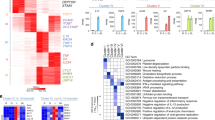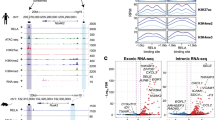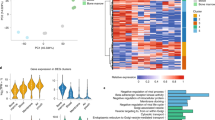Abstract
Toll-like receptors (TLRs) induce a multi-component inflammatory response that must be tightly regulated to avoid tissue damage. Most known regulatory mechanisms target TLR signalling pathways and thus broadly inhibit multiple aspects of the inflammatory response. Given the functional diversity of TLR-induced genes, we proposed that additional, gene-specific regulatory mechanisms exist to allow individual aspects of the TLR-induced response to be differentially regulated. Using an in vitro system of lipopolysaccharide tolerance in murine macrophages, we show that TLR-induced genes fall into two categories on the basis of their functions and regulatory requirements. We demonstrate that representatives from the two classes acquire distinct patterns of TLR-induced chromatin modifications. These gene-specific chromatin modifications are associated with transient silencing of one class of genes, which includes pro-inflammatory mediators, and priming of the second class, which includes antimicrobial effectors. These findings illustrate an adaptive response in macrophages and reveal component-specific regulation of inflammation.
This is a preview of subscription content, access via your institution
Access options
Subscribe to this journal
Receive 51 print issues and online access
$199.00 per year
only $3.90 per issue
Buy this article
- Purchase on Springer Link
- Instant access to full article PDF
Prices may be subject to local taxes which are calculated during checkout






Similar content being viewed by others
References
Nathan, C. Points of control in inflammation. Nature 420, 846–852 (2002)
Takeda, K., Kaisho, T. & Akira, S. Toll-like receptors. Annu. Rev. Immunol. 21, 335–376 (2003)
Nieuwdorp, M., Stroes, E. S., Meijers, J. C. & Buller, H. Hypercoagulability in the metabolic syndrome. Curr. Opin. Pharmacol. 5, 155–159 (2005)
Karin, M., Lawrence, T. & Nizet, V. Innate immunity gone awry: Linking microbial infections to chronic inflammation and cancer. Cell 124, 823–835 (2006)
Liew, F. Y., Xu, D., Brint, E. K. & O’Neill, L. A. Negative regulation of toll-like receptor-mediated immune responses. Nature Rev. Immunol. 5, 446–458 (2005)
Beeson, P. B. Tolerance to bacterial pyrogens I: Factors influencing its development. J. Exp. Med. 86, 29–38 (1947)
Beeson, P. B. Tolerance to bacterial pyrogens II: Role of the reticulo-endothelial system. J. Exp. Med. 86, 39–44 (1947)
West, M. A. & Heagy, W. Endotoxin tolerance: A review. Crit. Care Med. 30, S64–S73 (2002)
Cavaillon, J. M. & Adib-Conquy, M. Bench to bedside review: Endotoxin tolerance as a model of leukocyte reprogramming in sepsis. Crit. Care 10, 1–8 (2006)
Dobrovolskaia, M. A. & Vogel, S. N. Toll receptors, CD14, and macrophage activation and deactivation by LPS. Microbes Infect. 4, 903–914 (2002)
Fujihara, M. et al. Molecular mechanisms of macrophage activation and deactivation by lipopolysaccharide: roles of the receptor complex. Pharmacol. Ther. 100, 171–194 (2003)
Medvedev, A. E., Kopydlowski, K. M. & Vogel, S. N. Inhibition of lipopolysaccharide-induced signal transduction in endotoxin-tolerized mouse macrophages: Dysregulation of cytokine, chemokine, and toll-like receptor 2 and 4 gene expression. J. Immunol. 164, 5564–5574 (2000)
Medvedev, A. E., Lentschat, A., Wahl, L. M., Golenbock, D. T. & Vogel, S. N. Dysregulation of LPS-induced Toll-like receptor 4-MyD88 complex formation and IL-1 receptor-associated kinase 1 activation in endotoxin-tolerant cells. J. Immunol. 169, 5209–5216 (2002)
Fujihara, M. et al. Lipopolysaccharide-triggered desensitization of TNF-α mRNA expression involves lack of phosphorylation of IκBα in a murine macrophage-like cell line, P388D1. J. Leukoc. Biol. 68, 267–276 (2000)
Dobrovolskaia, M. A. et al. Induction of in vitro reprogramming by Toll-like receptor (TLR)2 and TLR4 agonists in murine macrophages: Effects of TLR “homotolerance” versus “heterotolerance” on NF-κ B signaling pathway components. J. Immunol. 170, 508–519 (2003)
Huang, Q. et al. The plasticity of dendritic cell responses to pathogens and their components. Science 294, 870–875 (2001)
Ogawa, S. et al. Molecular determinants of crosstalk between nuclear receptors and toll-like receptors. Cell 122, 707–721 (2005)
De Bosscher, K., Vanden Berghe, W. & Haegeman, G. The interplay between the glucocorticoid receptor and nuclear factor-κB or activator protein-1: Molecular mechanisms for gene repression. Endocr. Rev. 24, 488–522 (2003)
Narlikar, G. J., Fan, H. Y. & Kingston, R. E. Cooperation between complexes that regulate chromatin structure and transcription. Cell 108, 475–487 (2002)
Chi, T. A BAF-centred view of the immune system. Nature Rev. Immunol. 4, 965–977 (2004)
Strahl, B. D. & Allis, C. D. The language of covalent histone modifications. Nature 403, 41–45 (2000)
Jenuwein, T. & Allis, C. D. Translating the histone code. Science 293, 1074–1080 (2001)
Kurdistani, S. K. & Grunstein, M. Histone acetylation and deacetylation in yeast. Nature Rev. Mol. Cell Biol. 4, 276–284 (2003)
Leoni, F. et al. The histone deacetylase inhibitor ITF2357 reduces production of pro-inflammatory cytokines in vitro and systemic inflammation in vivo. Mol. Med. 11, 1–15 (2005)
Nusinzon, I. & Horvath, C. M. Unexpected roles for deacetylation in interferon- and cytokine-induced transcription. J. Interferon Cytokine Res. 25, 745–748 (2005)
Santos-Rosa, H. et al. Active genes are tri-methylated at K4 of histone H3. Nature 419, 407–411 (2002)
Schneider, R. et al. Histone H3 lysine 4 methylation patterns in higher eukaryotic genes. Nature Cell Biol. 6, 73–77 (2004)
Pokholok, D. K. et al. Genome-wide map of nucleosome acetylation and methylation in yeast. Cell 122, 517–527 (2005)
Bernstein, B. E. et al. Genomic maps and comparative analysis of histone modifications in human and mouse. Cell 120, 169–181 (2005)
Metzger, E. et al. LSD1 demethylates repressive histone marks to promote androgen-receptor-dependent transcription. Nature 437, 436–439 (2005)
Ramirez-Carrozzi, V. R. et al. Selective and antagonistic functions of SWI/SNF and Mi-2β nucleosome remodeling complexes during an inflammatory response. Genes Dev. 20, 282–296 (2006)
Kaufmann, A., Gemsa, D. & Sprenger, H. Differential desensitization of lipopolysaccharide-inducible chemokine gene expression in human monocytes and macrophages. Eur. J. Immunol. 30, 1562–1567 (2000)
Learn, C. A., Mizel, S. B. & McCall, C. E. mRNA and protein stability regulate the differential expression of pro- and anti-inflammatory genes in endotoxin-tolerant THP-1 cells. J. Biol. Chem. 275, 12185–12193 (2000)
Henricson, B. E., Manthey, C. L., Perera, P. Y., Hamilton, T. A. & Vogel, S. N. Dissociation of lipopolysaccharide (LPS)-inducible gene expression in murine macrophages pretreated with smooth LPS versus monophosphoryl lipid A. Infect. Immun. 61, 2325–2333 (1993)
Shnyra, A., Brewington, R., Alipio, A., Amura, C. & Morrison, D. C. Reprogramming of lipopolysaccharide-primed macrophages is controlled by a counterbalanced production of IL-10 and IL-12. J. Immunol. 160, 3729–3736 (1998)
Flohe, S. et al. Endotoxin tolerance in rats: Expression of TNF-α, IL-6, IL-10, VCAM-1 and HSP 70 in lung and liver during endotoxin shock. Cytokine 11, 796–804 (1999)
Smale, S. T. The establishment and maintenance of lymphocyte identity through gene silencing. Nature Immunol. 4, 607–615 (2003)
Acknowledgements
We thank S. Smale, T. Chi, M. Wan and R. Rutishauser for discussions, gifts of reagents, and technical assistance. S.L.F. is supported by the UNCF-Merck Graduate Science Research Dissertation Fellowship and by the NIH. D.C.H. is supported by the NSF and the graduate programme at Yale University. R.M. is supported by funding from the Howard Hughes Medical Institute, and the NIH.
All microarray data are available from the Gene Expression Omnibus database (http://www.ncbi.nlm.nih.gov/geo) under accession code GSE7348.
Author information
Authors and Affiliations
Corresponding author
Ethics declarations
Competing interests
Reprints and permissions information is available at www.nature.com/reprints. The authors declare no competing financial interests.
Supplementary information
Supplementary Information
This file contains Supplementary Figures 1-5 and Supplementary Table 2. Supplementary Figure 1 shows pie chart representations of 50 of the top 100 genes from the class T and NT categories divided into functional groups. Supplementary Figure 2 shows more gene examples from Figure 1f, 1g, and 2b. Supplementary Figure 3 shows class NT gene induction is not due to increased mRNA stability, increased sensitivity to LPS, or positive feedback of secreted factors. Supplementary Figure 4 shows class T and NT genes are induced by the same signaling pathways in naive and tolerant macrophages, despite reduced signalling in tolerant macrophages. Supplementary Figure 5 shows reversal of suppression of class T genes following TSA, Pargyline, or DRB treatment is not due to changes in signalling in tolerant macrophages. Supplementary Table 2 shows individual gene names listed for genes represented in the pie charts in Supplementary Figure 1. (PDF 1557 kb)
Supplementary Table 1
This file contains Supplementary Table 1. The table contains expression data for genes differentially regulated in naïve and tolerant macrophages stimulated with LPS. Microarray analysis and gene selection was performed as described in Supplementary Methods. a) Class T genes. b) Class NT genes. (XLS 141 kb)
Rights and permissions
About this article
Cite this article
Foster, S., Hargreaves, D. & Medzhitov, R. Gene-specific control of inflammation by TLR-induced chromatin modifications. Nature 447, 972–978 (2007). https://doi.org/10.1038/nature05836
Received:
Accepted:
Published:
Issue Date:
DOI: https://doi.org/10.1038/nature05836
This article is cited by
-
Dectin-1 ligands produce distinct training phenotypes in human monocytes through differential activation of signaling networks
Scientific Reports (2024)
-
Naïve Huntington’s disease microglia mount a normal response to inflammatory stimuli but display a partially impaired development of innate immune tolerance that can be counteracted by ganglioside GM1
Journal of Neuroinflammation (2023)
-
Innate immune memory in inflammatory arthritis
Nature Reviews Rheumatology (2023)
-
Processing stimulus dynamics by the NF-κB network in single cells
Experimental & Molecular Medicine (2023)
-
Soluble CD4 effectively prevents excessive TLR activation of resident macrophages in the onset of sepsis
Signal Transduction and Targeted Therapy (2023)
Comments
By submitting a comment you agree to abide by our Terms and Community Guidelines. If you find something abusive or that does not comply with our terms or guidelines please flag it as inappropriate.



